
Welcome to our comprehensive guide on how to hide the Taskbar in Windows 11! Whether you’re a screen space enthusiast or just tired of your Taskbar hogging the limelight, mastering the art of hiding the Taskbar in Windows 11 is a must.
In this guide, we’ll navigate through various methods to discreetly tuck away your Taskbar, giving your desktop a sleek and minimalist vibe. So, let’s embark on this journey of tidying up the desktop and reclaiming our screen real estate in style!
Table of Contents
How to Hide Taskbar in Windows 11
Hiding the Taskbar in Windows 11 is a simple process, with a few different ways to do it. Let’s explore each method step by step:
Method 1: Enable Auto Hide Taskbar in Settings
Windows 11 offers a built-in option to enable or disable the feature to hide the Taskbar automatically. This feature comes in handy when looking for an option that makes the Taskbar go away automatically after a few seconds, allowing you more screen room to work with and fewer distractions.
Here’s how to enable the Auto-Hide Taskbar on your Windows 11 PC.
- Move your mouse pointer to the bottom of your screen where the Taskbar is located. When you see the Taskbar, which is the bar that usually shows icons like the Start button, running applications, and system notifications, click the right mouse button. This action will bring up a small menu with different options.
- From the menu that appears after right-clicking on the Taskbar, look for an option called “Taskbar settings” and click on it. This will open up the settings window specifically for the Taskbar.

- In the taskbar settings window, you’ll see several options; click and expand the “Taskbar behaviors” section. Now, look for options labeled “Automatically hide the taskbar.” This Taskbar setting controls whether the Taskbar automatically hides when you’re not using it. To make the Taskbar automatically hide, click the toggle switch next to it. When the switch is in the on position, it means the feature is enabled.
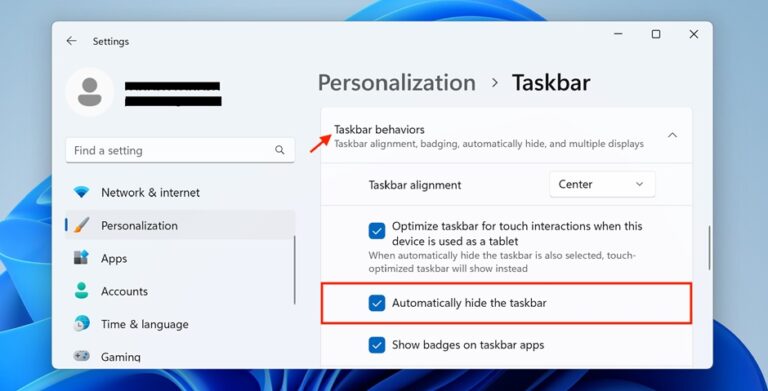
In the future, if you want to disable the auto-hide feature, simply follow the above steps again and uncheck Automatically hide the taskbar option.
Following these simple steps, you can automatically hide the Taskbar, even when in fullscreen mode on your Windows 11 computer. This can help you focus better on your work or entertainment without distractions from the Taskbar.
Important Safety Precautions Before doing Registry Setting
Method 2 and Method 3 below modify registry setting. So before making any registry changes, it is advisable to take these important safety measures:
- Click the Start menu and type “create a restore point” in the search box. Click on the matching result that appears at the top of the search results.

- Look for the System Protection tab in the System Properties dialog that opens. This tab contains system restore settings and options.

- Click the Create button near the bottom of the dialog to make a new restore point. This creates a backup of your current system configuration.

- Enter a descriptive name like “Before taskbar registry modifications” when prompted for a restore point description. This helps you identify the restore point if you need to revert changes later. Click Create
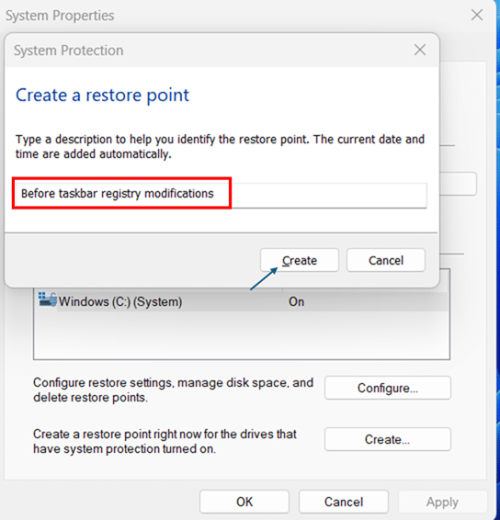
- Wait for the confirmation message that says “The restore point was created successfully” before proceeding with any registry modifications. This ensures you have a safety net in case something goes wrong.
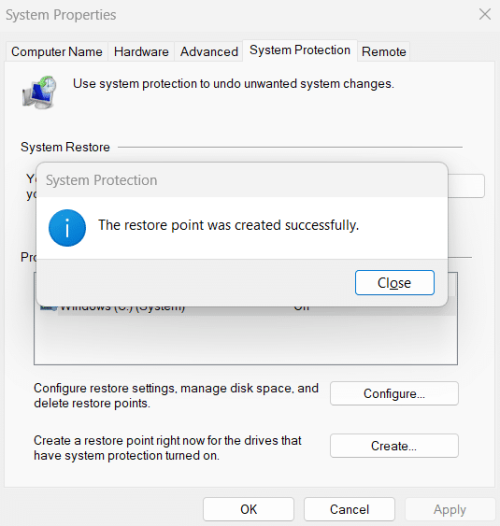
Method 2: Hide the Taskbar Using PowerShell
For those comfortable with exploring more advanced options, PowerShell can be a useful tool for customizing Windows settings. Here’s how you can use PowerShell to hide the Taskbar:
- To begin, press the “Windows” key on your keyboard to open the Start menu.
- In the Start menu search bar, type “PowerShell” and click the “Run as administrator” option. This action will launch the PowerShell application with elevated permissions.
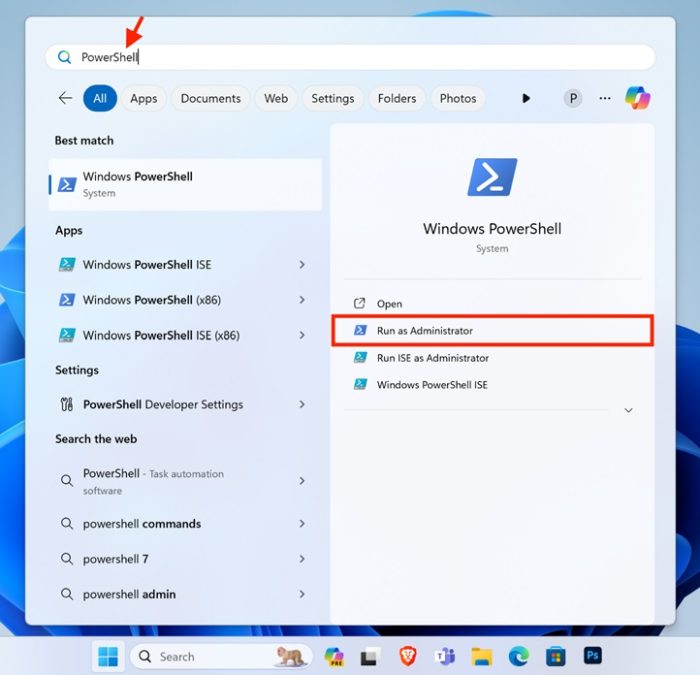
- Alternatively, you can also right-click on the PowerShell option from the search results and click on “Run as administrator.”
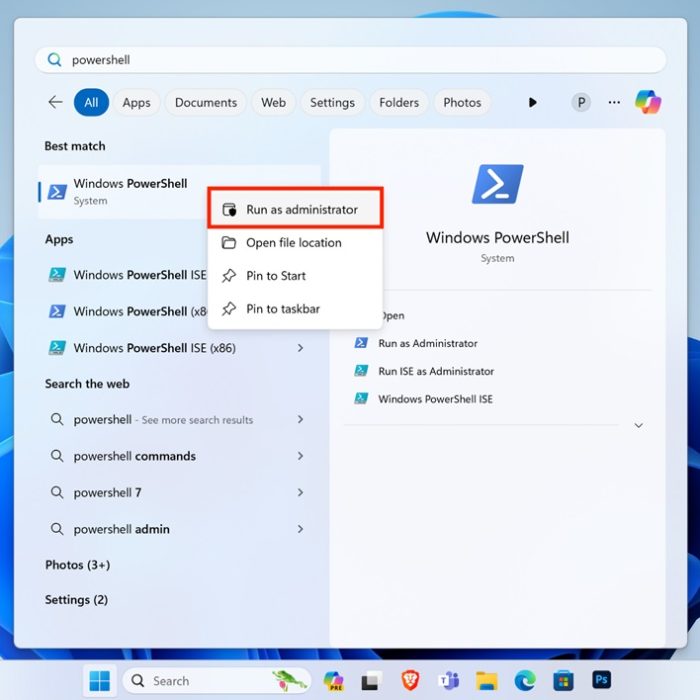
- Once PowerShell is open, you’ll see a command prompt where you can type commands. Copy the following command:
& { $p=‘HKCU:\SOFTWARE\Microsoft\Windows\CurrentVersion\Explorer\StuckRects3’ $v=(Get-ItemProperty –Path $p).Settings $v[8]=3 Set-ItemProperty –Path $p –Name Settings –Value $v Stop-Process –f –ProcessName explorer }
- Press Enter to run the command.
- After pressing Enter, PowerShell will process the command. This command instructs Windows to hide the Taskbar.
Once the command has been executed, you’ll see that your Taskbar is gone.
- To get back your Taskbar, you can execute the following command:
& { $p=‘HKCU:\SOFTWARE\Microsoft\Windows\CurrentVersion\Explorer\StuckRects3’ $v=(Get-ItemProperty –Path $p).Settings $v[8]=2 Set-ItemProperty –Path $p –Name Settings –Value $v Stop-Process –f –ProcessName explorer }
And your Taskbar is now back on your desktop.
Method 3: Hide the Taskbar Using the Command Prompt
Command Prompt is another command line utility that you can use to hide and unhide your taskbar. The procedure is quite similar to what explained in the previous method using PowerShell. Only the command that you’ll have to execute is going to be a bit different. Here’s a detailed steps to hide and unhide the Taskbar using CMD:
- Press the “Windows” key on your keyboard, type “Command Prompt” in the search bar, and select “Run as administrator” to open Command Prompt with required admin permissions.
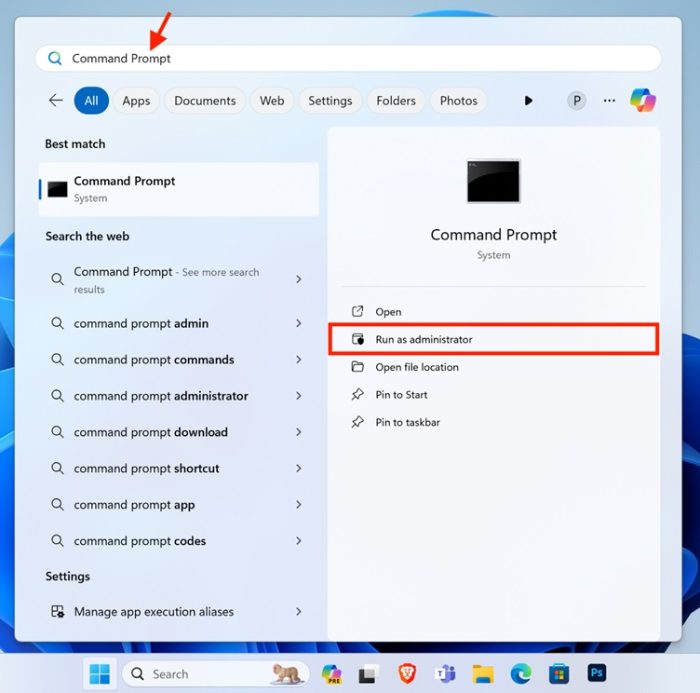
- You can also simply right-click on the Command Prompt search result and select “Run as administrator.”
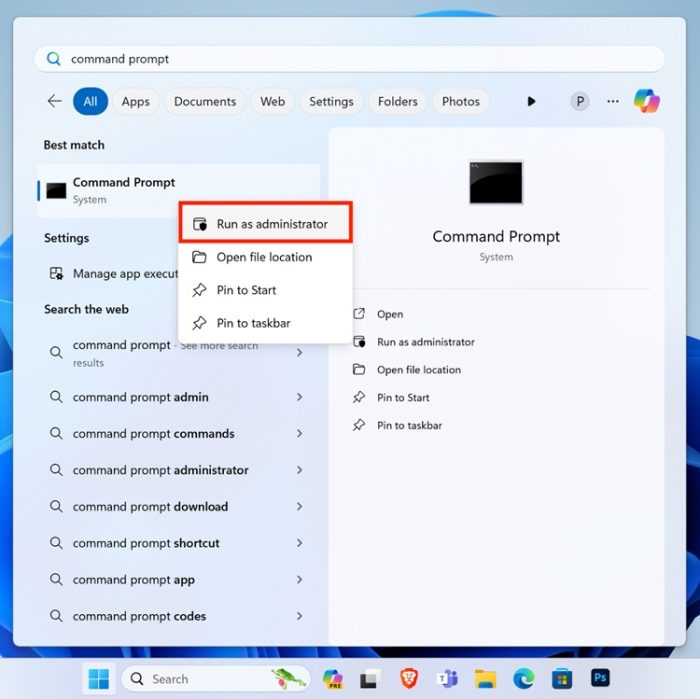
- In the Command Prompt window, type the following command and press Enter to execute it:
powershell -command "& {$p='HKCU:\SOFTWARE\Microsoft\Windows\CurrentVersion\Explorer\StuckRects3';$v=(Get-ItemProperty -Path $p).Settings;$v[8]=3;Set-ItemProperty -Path $p -Name Settings -Value $v;Stop-Process -f -ProcessName explorer}"

- To bring back the Taskbar, type the following command and press Enter:
powershell -command "& {$p='HKCU:\SOFTWARE\Microsoft\Windows\CurrentVersion\Explorer\StuckRects3';$v=(Get-ItemProperty -Path $p).Settings;$v[8]=2;Set-ItemProperty -Path $p -Name Settings -Value $v;Stop-Process -f -ProcessName explorer}"
This command restores the Taskbar to its default state. Your Taskbar will now be visible again on your desktop and everywhere else, as usual.
How to Fix if Taskbar is Not Hiding in Windows 11
The Windows 11 taskbar is a handy feature that provides quick access to various applications and system functions. However, there may be instances where the Taskbar refuses to hide, causing inconvenience to users. Here are some common reasons why the Taskbar may not be hiding and provide step-by-step solutions to resolve the issue.
Fix 1. Try Restarting the Windows Explorer Process
The Windows Explorer process is responsible for managing the graphical user interface, including the Taskbar. If this process encounters any issues, it may prevent the Taskbar from hiding properly on your Windows desktop. To resolve this issue, follow these steps:
- Right-click on the Start icon and select “Task Manager.”
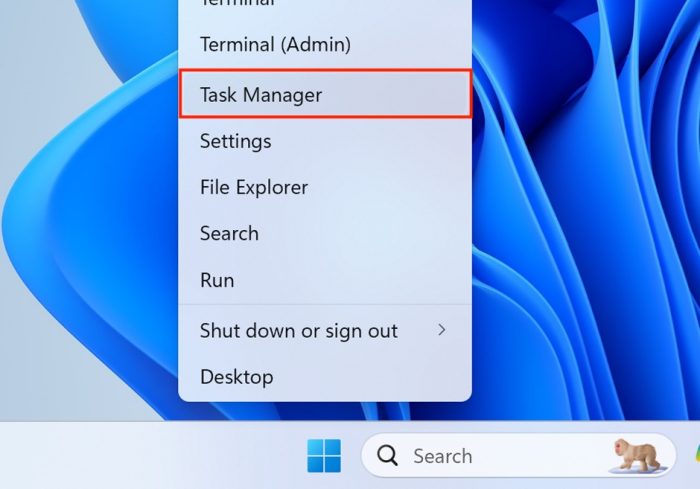
- In the Processes tab, locate “Windows Explorer,” right-click on it, and select “Restart.”
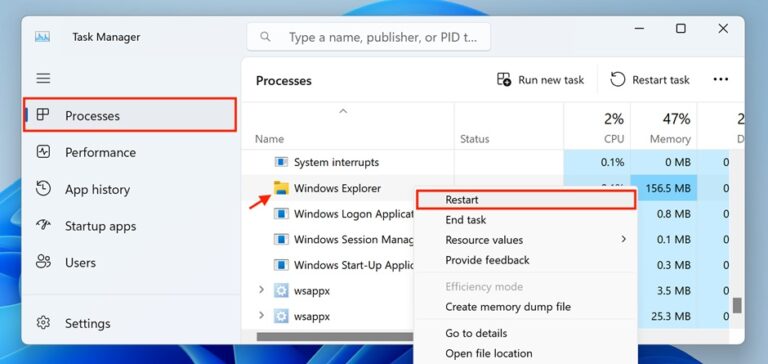
- The Taskbar will disappear momentarily before reappearing. Check if the issue persists.
Fix 2. Check for Active Apps and Programs
An active app or program may sometimes prevent the Taskbar from hiding if it requires your attention. Look for glowing app icons on the Taskbar indicating an alert or notification. Click on the glowing icon and address the notification to allow the Taskbar to hide automatically.
Fix 3. Turn off Notification or Change Notification Settings for the Concerned Apps
Certain apps may continuously send notifications, preventing the Taskbar from hiding. You can modify the notification settings for these apps to resolve the issue. Disable unwanted notifications or disable notifications for the app entirely to allow the Taskbar to hide properly.
Fix 4. Try Re-registering the Taskbar Using Command Prompt
If the problem persists, you can re-register the Windows taskbar to restore its functionality. Follow these steps:
- Press the “Windows” key, search for “Command Prompt” in the search box, and select “Run as administrator.”
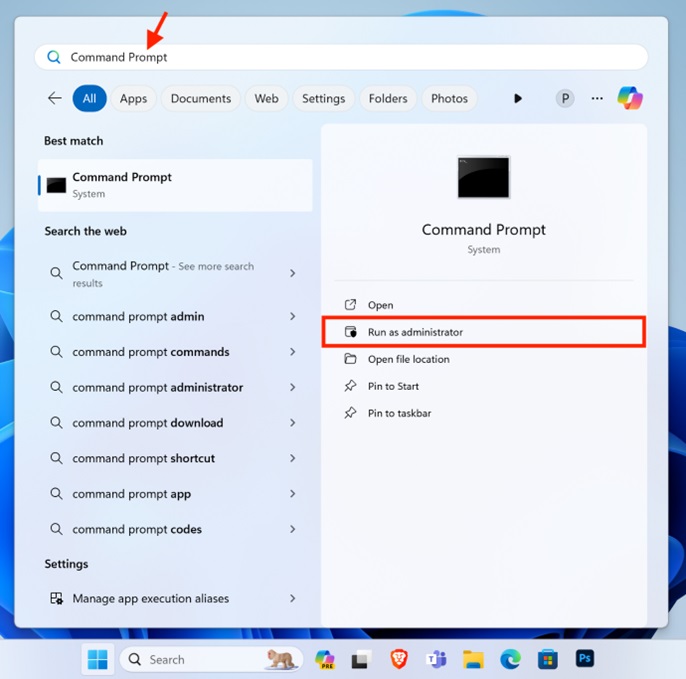
- In the Command Prompt window, paste the following command and press Enter:
reg add “HKCU\SOFTWARE\Microsoft\Windows\CurrentVersion\Explorer\StuckRects3” /v Settings /t REG_BINARY /d 28000000 /f
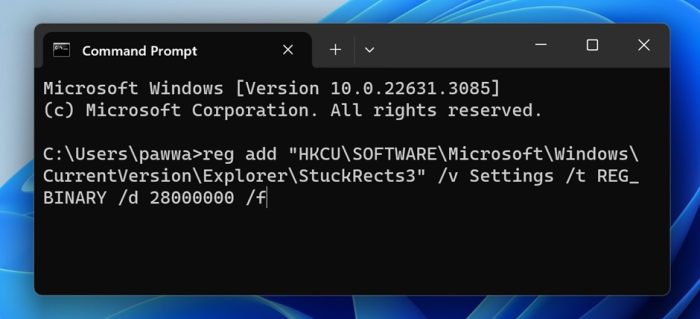
- Close the Command Prompt window and navigate to C:\Users[Your Username]\AppData\Local. Delete the “TileDataLayer” folder.
Fix 5. Run System File Checker (SFC) and Deployment Image Servicing and Management (DISM) Scans
Corrupted or missing system files may also cause the Taskbar to malfunction. Run an SFC scan followed by a DISM scan to repair damaged system files. Here’s how:
- Open Command Prompt as administrator and run the following command:
sfc /scannow

- After the scan is complete, run the following command:
DISM.exe /Online /Cleanup-image /Restorehealth

- Restart your Windows 11 PC and check if the Taskbar automatically hides as expected.
Check for Pending Windows Updates
Ensure your system is up to date by installing any available Windows updates. Head to the Windows Update section in the Settings app, check for updates, and install them. Updates often include bug fixes that may resolve the taskbar issue.
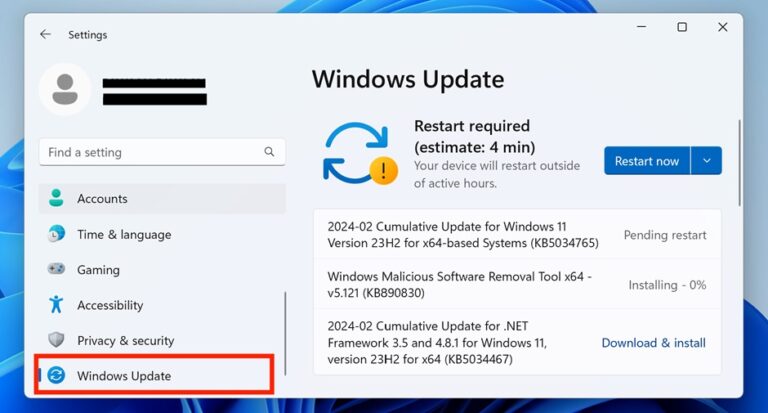
By following these troubleshooting steps, you should be able to resolve the issue of the Taskbar not hiding in Windows 11. If the problem persists, consider seeking further assistance from Microsoft support or a qualified technician.
Conclusion
Congratulations! You’ve successfully learned how to hide the Taskbar in Windows 11. Whether you are looking for a cleaner desktop or trying to maximize your screen space, hiding the Taskbar can help you achieve your goals. With the simple methods outlined in this guide, you can customize your Windows 11 experience to suit your preferences perfectly. Happy computing!
Frequently Asked Questions (FAQs)
Q1. Why Is My Windows 11 Taskbar Not Hiding?
If you’re having trouble hiding the Taskbar, don’t worry – we’ve got some troubleshooting tips for you:
- Make sure the “Automatically hide the taskbar” option is turned on in your taskbar settings.
- Check for third-party apps or programs that might prevent the Taskbar from hiding.
- Update your Windows 11 system to the latest version to rectify bugs or issues.
Q2. Why Doesn’t My Taskbar Hide When I Go Fullscreen?
If the Taskbar is still visible in fullscreen mode, try these solutions:
- Make sure the app or program you’re using supports full screen mode.
- Disable any overlays or toolbars that might be conflicting with the taskbar hiding feature.
- Update your graphics drivers to the latest version.
Q3. Will hiding the Taskbar affect its functionality?
Hiding the Taskbar does not affect its functionality. You can still access all the features and shortcuts by moving your mouse cursor to the edge of the screen where the Windows 11 taskbar is hidden.
Q4. Is it possible to hide the Taskbar on specific monitors in a multi-monitor setup?
Currently, Windows 11 does not offer built-in support for hiding the Taskbar on specific monitors in a multi-monitor setup. However, third-party software may provide this functionality.
Q5. Are there any shortcuts to quickly toggle the taskbar visibility?
Windows does not provide built-in shortcuts for toggling taskbar visibility. However, you can use third-party tools or create custom shortcuts using scripting languages like AutoHotkey.




